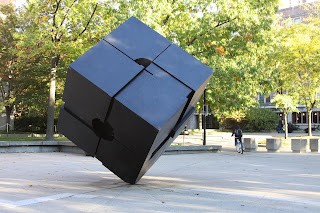Fleming Administration Building / The Cube
Introduction
Text-to-speech Audio
Some students stay in town, but most go home, work summer jobs, or have summer internships only to return in the fall for another year of school and football.
1998 was a bit different than usual, however. A group of students who completed Union Summer internships with the AFL-CIO, the largest American labor union, started SOLE, Students Organizing for Labor and Economic Equality, upon their return to Ann Arbor.
Images
The Cube

Backstory and Context
Text-to-speech Audio
At the same time in the 90s, anti-sweatshop activism was gaining traction across the US. The United States signed on to global free trade agreements, which led to companies increasingly using overseas factories to produce their goods. Disputes over the free trade agreements sparked media attention, often exposing working conditions in these factories to the public.
On campus, SOLE led the anti-sweatshop activism movement. They called on the university to take responsibility for where and how it got its gear. SOLE pinpointed the athletic department, establishing a “Just Don’t Do It” campaign against its Nike contract. Still, students felt there was more to be done. With inspiration from Duke University students, SOLE held a sit-in right here, in the Fleming Building, where President Lee Bollinger’s office sat.
SOLE sent their “No-Sweat 30” into Bollinger’s office on St. Patrick’s Day, 1999. Throughout their 51-hour sit-in, the students talked strategy, held press interactions (TIME magazine included), and did team-bonding activities. Yes, they even had a dance party while protesting. They were also one of the first groups to use cell phones during a sit-in at Michigan. From inside, students phoned the media and kept in touch with supporters. Both groups proved helpful during the more-than-two day protest. Faculty and students brought protestors food; people wrote messages of solidarity on the cube; and the United Auto Workers announced their support.
SOLE was largely white, which likely affected how much media attention they garnered. Even The Michigan Daily favored SOLE, at least by number of articles, over the Students of Color Coalition, which earlier that year occupied the Michigan Union in a protest against the secret society Michigamua—which you’ll hear about later in the tour.
Despite the support, SOLE faced counter-protestors: a student group called “SPEED” marched around the Cube in favor of free trade. Media and cause popularity drove SOLE to a win. Negotiations brought updates to the university’s purchasing code of conduct and established a labor standards committee, more or less replacing SOLE over the next few years.
The organization had their last stint in 2007 when they occupied President Mary Sue Coleman’s office, but their legacy certainly lives on. SOLE proved the university wrong in a few ways, notably by showing that the Fleming Building, was not, as it had been claimed to be, “protester resistant.”
Sources
Brandon III, Ira, Matthew Lassiter, Mary Bridget Lee, Alec Ramsay-Smith. Ending the Business of Injustice: Anti-Sweatshop Activism at the University of Michigan, 1999-2007 (online exhibit). Accessed October 20, 2022.
Mikoyan. (1970, January 1). The endover cube. Michigan Exposures. Retrieved November 28, 2022, from http://michiganexposures.blogspot.com/2010/10/endover-cube.html
